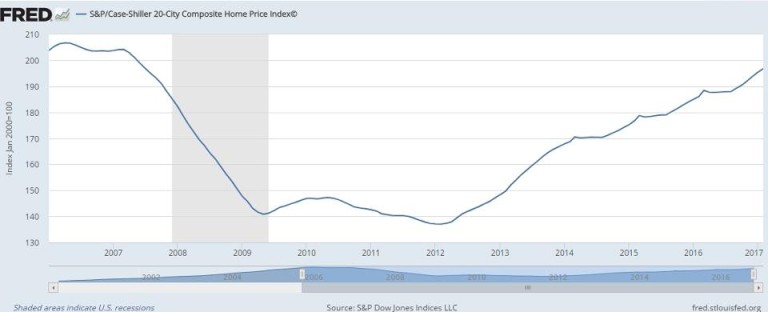- | Housing Housing
- | Expert Commentary Expert Commentary
- |
Housing Prices Are Rising and Technology Is Contributing
Housing prices in many cities are high and rising—the Case-Shiller 20-city home price index is almost at pre-recession levels—and this is drawing the ire of renters, homebuyers and local politicians. Housing prices typically rise because increases in demand outpace increases in supply, and demand is driven by an area’s attractiveness. The cities experiencing the biggest price increases are places with pleasant climates, appealing amenities, booming economies or all three. In addition to the quantity of amenities—such as the number of nearby restaurants—new research finds that the quality of nearby amenities also impacts housing prices. 
Economic theory predicts that the value of a neighborhood’s amenities, which includes access to public transit and parks, local school quality and access to bars and restaurants—among other things—is capitalized into home values. New Yorkers or Washingtonians have probably noticed this, as homes and apartments near Central Park and metro stations are typically more expensive than similar apartments located further away. Beach-front property typically commands a premium as well.
Amenities like Central Park, a beach or a metro station are obvious to home buyers, as is the number of restaurants nearby. They can easily incorporate the presence of these attractions into their calculations when determining how much to pay for a property.
But people also care about the quality of nearby parks and restaurants, not just that they exist. Unfortunately, information about the quality of nearby amenities has historically been less accessible than information about existence, which has made it difficult for home buyers and sellers to account for it.
Over the last decade or so, technology has made it easier to get data on quality via user ratings on websites such as Yelp. Researchers are now using this data to examine how amenity quality affects home values. A recent study in the Journal of Urban Economics that uses data from Washington D.C. finds that restaurant quality, as measured by Yelp reviews, impacts property values: A doubling of the number of highly rated restaurants (rating > 3.4) within a mile radius of a home is associated with an 11.5% increase in the home’s value.
The author also looks at the relationship between restaurant prices and home values and finds that restaurants that provide good value—by being inexpensive and highly rated—are the only type of restaurant associated with higher home values.
Additionally, the relationship between restaurant quality and home values has only existed in D.C. since Yelp became popular in the area in 2008. Prior to that, the author finds no significant relationship.
This implies that Yelp solved an information problem. Prior to Yelp, people had imperfect information about a restaurant’s quality, making it difficult for sellers and buyers of homes to incorporate the value of proximity to high quality restaurants into home prices. After Yelp made this information accessible, it was capitalized into the value of the home, just like proximity to conspicuous amenities like Central Park or the beach.
More information helps people make better decisions, so websites like Yelp, Trip Advisor and others have certainly improved people’s lives. More information also makes it easier for us to find the things we like and stick with them, rather than relying on the trial and error process that exposes us to new—perhaps less satisfying—goods and experiences.
On an individual basis this tends to make us happier. But as Tyler Cowen discusses in his book, The Complacent Class, more information can also segregate us, as it enables us to constantly surround ourselves with familiar foods and faces. From a macro standpoint, sorting by tastes and income, and the complacency it breeds, can hurt the dynamism of our economy in the long run.
More information about amenity quality contributes to further sorting by income. As the aforementioned study shows, housing prices increase in areas with the best amenities as the quality of those amenities becomes well known. This will make it harder for lower income people to afford housing in these areas. In the past, when quality information was absent, lower income people, due to luck or local knowledge, could occasionally afford housing in the best neighborhoods.
Some argue that rent control or inclusionary zoning is needed to restore affordability, but neither of these policies get at the core of the problem, which is demand outpacing supply. As I have written elsewhere, more building is the only cure for expensive housing and more building can’t occur until cities reform their land-use regulations.
Excessive land-use regulations not only restrict new housing, but the evidence is piling up that they decrease national economic output—and make us all poorer—by making it difficult for people to live in the most productive areas of the country.
Technology is making it easier for us to gather and share information with one another about all sorts of things. Because of this, the economy needs to be more flexible than ever. Unfortunately, governments are often slow to react or fall prey to vocal special interests intent on maintaining the status quo. More information should improve the functioning of the economy, but in some cases rigid government policies make it a double-edged sword.